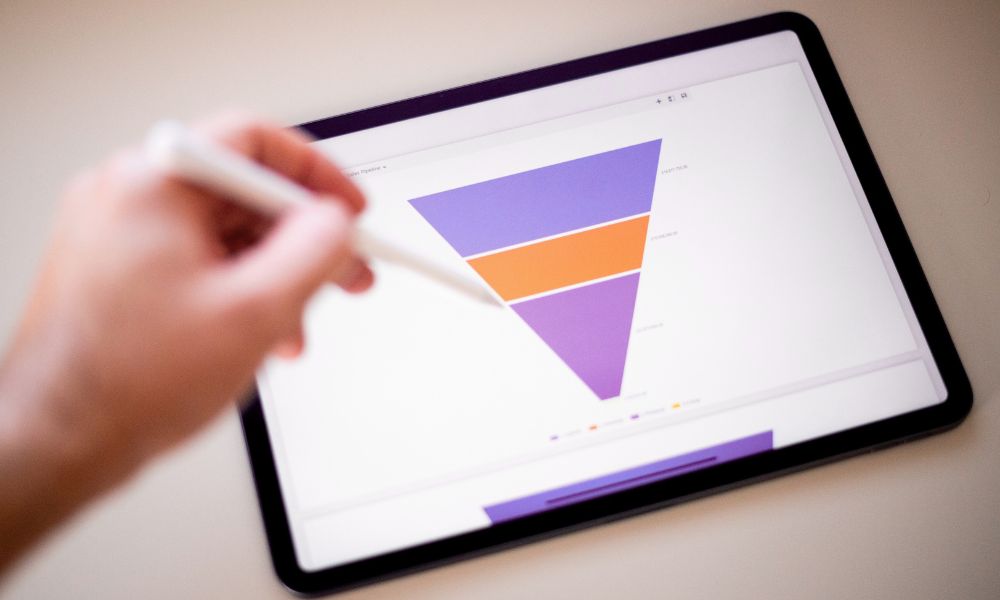
B2B PPC can deliver impressive ROI when it’s done right. But many campaigns fall short not because of the channel, but because of outdated structures, misaligned messaging, or a lack of ongoing refinement. The difference between ‘spend and hope’ and high-performing paid strategies is often down to the details.
We’re sharing practical B2B PPC tips to help you optimise your campaigns, whether you’re already running paid search or just looking to refine your approach. From funnel mapping to message alignment, these tips are designed to help you get more from every click.
B2B Google Ads often sit alongside broader PPC strategies, where refinement can make a significant difference.
Align campaign structure with funnel stages
Too often, B2B PPC campaigns are built flat, with the same creative, offer and targeting used across every audience. But decision-makers at the awareness stage don’t want the same thing as someone who’s already considering your product.
Instead, align your campaign structure with the buyer journey:
- Create separate PPC campaigns for B2B audiences at the top (TOFU), middle (MOFU) and bottom (BOFU) of the funnel.
- Use relevant offers at each stage: TOFU audiences may respond better to educational content, while BOFU audiences are primed for demos or pricing pages.
- Avoid blending cold and warm audiences. Keep your targeting focused and build journeys that nurture, rather than rush, the sale.
This structure gives you better control over budgets, messaging and measurement at every stage.
Nail down your audience targeting
In B2B, it’s not just about reach, it’s about reaching the right people. A solid B2B PPC strategy needs clear, specific targeting to ensure you’re not wasting spend on low-fit traffic.
Some tips to sharpen your approach:
- Build audiences using job titles, company size, industry and other firmographic data.
- Import first-party data from your CRM to create matched audiences or lookalikes based on real customers.
- Be cautious with broad lookalikes or interest-based audiences, especially in early-stage testing. Precision pays off.
With B2B paid media strategy, quality matters more than volume. Strong targeting improves click-through rate, lowers cost-per-lead and gives your sales team better opportunities to convert.
Prioritise messaging that speaks to business impact
In B2B, flashy creative isn’t what converts, relevance is. Your ad copy should speak directly to the problems your buyers are trying to solve and the outcomes they care about.
Here’s how to keep your messaging sharp:
- Lead with value. Talk about saving time, reducing cost, or improving efficiency, not just what your product does.
- Use social proof wherever possible. Logos, testimonials, case study stats, all of these build trust.
- Align language and tone with intent. Someone reading a TOFU ad might respond to curiosity, while a BOFU reader is looking for clarity and proof.
Much of what applies here also holds true for B2B display ads, particularly when it comes to capturing attention through relevant messaging.
Get your landing pages right
Even the best-written PPC ad won’t deliver results if the post-click experience isn’t aligned. Your landing pages should support the message, intent and tone of your ads.
Here’s what to focus on:
- Match the headline and CTA from your ad copy to create a clear, frictionless user journey.
- For TOFU campaigns, consider ungated content or short forms to reduce drop-off.
- Use tools like Hotjar, GA4 or Microsoft Clarity to understand where users are dropping off or getting stuck.
Your B2B paid search strategy should extend beyond the ad itself. The journey from click to conversion is where you either build momentum or lose interest.
Test, optimise and never settle
One of the biggest mistakes in B2B PPC is going live, then standing still. Without testing and iteration, even good campaigns will plateau.
To keep improving performance:
- A/B test headlines, images and calls to action. Sometimes small changes deliver big results.
- Adapt your bidding strategy to the campaign goal. For TOFU, consider cost-per-click or impressions; for BOFU, optimise for conversions.
- Double down on what works. Use your data to spot patterns and prioritise high-performing audience segments.
Testing isn’t just a tactic, it’s a mindset. Many of the same principles apply in B2B retargeting, especially when re-engaging warm leads post-click.
Use paid search and paid media together
Many teams treat paid search and paid media like separate disciplines. But combining the two can deliver stronger, more consistent results.
Here’s how to integrate both:
- Align your messaging across platforms, from LinkedIn and Google to programmatic and display, to support a unified customer journey.
- Use paid social to build awareness and warm up cold audiences. Then use retargeting and paid search to drive them toward action.
- Share insights across platforms. If a message or visual works well in one channel, test it in others.
A joined-up B2B paid media strategy brings consistency, efficiency and stronger ROI, and often involves finding the right external support to scale effectively.
Conclusion
Effective B2B PPC is about more than just clicks, it’s about creating a system that connects the right message with the right audience at the right time. From structuring campaigns around funnel stages to testing, learning and evolving your approach, each element plays a role in long-term success.
Start by auditing one of your existing campaigns. Look for mismatches in audience, message, or landing page experience. Then apply the tips above to rebuild with intent.
Small changes in the right places can create a big shift in results